ASANAS
Importance Of Asanas
Four Asanas are prescribed for the purpose of Japa and meditation. They are Padmasana, Siddhasana, Svastikasana and Sukhasana. You must be able to sit in any one of these four Asanas at a stretch for full three hours without shaking the body. Then only you will get Asana-Jaya, mastery over the Asana. Without securing a steady Asana, you cannot further get on well in meditation. The steadier you are in your Asana, the more you will be able to concentrate and make your mind one-pointed. If you can be steady in the posture even for one hour, you will be able to acquire one-pointed mind and feel thereby infinite peace and Atmic Ananda. When you sit on the posture, think: “I am as firm as a rock”. Give this suggestion to the mind half a dozen times. Then the Asana will become steady soon. You must become as a living statue when you sit for Dhyana. Then only there will be real steadiness in your Asana. In one year by regular practice you will have success and will be able to sit for three hours at a stretch. Start with half an hour and gradually increase the period. When you sit in the Asana, keep your head, neck and trunk in one straight line. Stick to one Asana and make it quite steady and perfect by repeated attempts. Never change the Asana. Adhere to one tenaciously. Realise the full benefits of one Asana. Asana gives Dridhata (strength). Mudra gives Sthirata (steadiness). Pratyahara gives Dhairya (boldness). Pranayama gives Laghima (lightness). Dhyana gives Pratyakshatva (perception) of Self and Samadhi gives Kaivalya (isolation) which is verily the freedom or final beatitude. The postures are as many in number as there are number of species of living creatures in this universe. There are 84 lakhs of Asanas described by Lord Siva. Among them 84 are the best and among these, 32 are very useful. There are some Asanas which can be practised while standing. These are Tadasana, Trikonasana, Garudasana, etc. There are some which can be practised by sitting, such as Paschimottanasana, Padmasana, etc. Some Asanas are done while lying down. These are Uttanapadasana, Pavanamuktasana, etc. Sirshasana, Vrikshasana, etc., are done with head downwards and legs upwards. In olden days these Asanas were practised in Gurukulas and so the people were strong and healthy and had long lives. In schools and colleges these Asanas should be introduced. Ordinary physical exercises develop the superficial muscles of the body only. One can become a Sandow with a beautiful physique by the physical exercises. But Asanas are intended for physical and spiritual development. Detailed instructions regarding the technique of 94 Asanas are given in my book ‘Yoga Asanas’ with illustrations. Here I will mention only a few of the Asanas that are useful for concentration, meditation and for awakening the Kundalini.1. Padmasana (Lotus Pose)
Amongst the four poses prescribed for Japa and Dhyana, Padmasana comes foremost. It is the best Asana for contemplation. Rishis like Gheranda, Sandilya, speak very highly of this vital Asana. This is highly agreeable for householders. Even ladies can sit in this Asana. Padmasana is suitable for lean persons and for youths as well. Sit on the ground by spreading the legs forward. Then place the right foot on the left thigh and the left foot on the right thigh. Place the hands on the knee-joints. You can make a fingerlock and keep the locked hands over the left ankle. This is very convenient for some persons. Or you can place the left hand over the left knee and then place the right hand over the right knee with the palm facing upwards and the index finger touching the middle portion of the thumb (Chinmudra).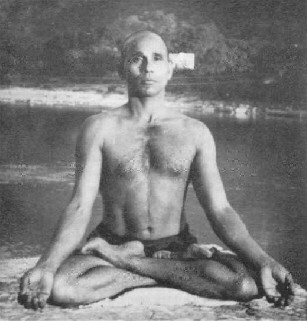
PADMASANA
2. Siddhasana (The Perfect Pose)
Next to Padmasana comes Siddhasana in importance. Some eulogise this Asana as even superior to Padmasana for purposes of Dhyana. If you get mastery over this Asana, you will acquire many Siddhis. Further it was being practised by many Siddhas of yore. Hence the name Siddhasana. Even fatty persons with big thighs can practise this Asana easily. In fact this is better to some persons than Padmasana. Young Brahmacharins who attempt to get established in celibacy should practise this Asana. This Asana is not suitable for ladies. Place one heel at anus. Keep the other heel on the root of the generative organ. The feet or legs should be so nicely arranged that the ankle-joints should touch each other. Hands can be placed as in Padmasana.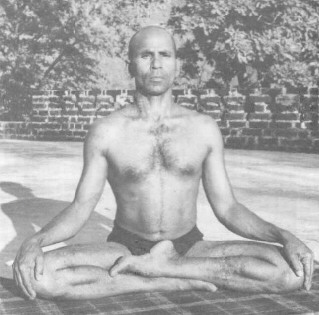
SIDDHASANA
3. Svastikasana (Prosperous Pose)
Svastikasana is sitting at ease with the body erect. Spread the legs forward. Fold the left leg and place the foot near the right thigh muscles. Similarly bend the right leg and push it in the space between the thigh and calf muscles. Now you will find the two feet between the thighs and calves of the legs. This is a very comfortable Asana. Those who find it difficult to do this, can sit in Samasana. Place the left heel at the beginning of right thigh and the right heel at the beginning of the left thigh. Sit at ease. Do not bend either on the left or right. This is called ‘Samasana’.4. Sukhasana
Any easy, comfortable posture for Japa and meditation is Sukhasana, the important point being the head, neck and trunk should be in a line without curve. People who begin Japa and meditation after 30 or 40 years of age generally are not able to sit in Padma, Siddha or Svastikasana for a long time. People sit in any wrong way and they call it ‘Sukhasana’. The trouble is even without their knowledge the backbone forms a curve in a few minutes. Now I will describe to you a nice Sukhasana whereby old persons can sit and meditate for a long time. Young persons should not try this. This is specially designed to suit old people who are unable to sit in Padmasana or Siddhasana in spite of repeated attempts. Take a cloth 5 cubits long. Fold it nicely length-wise till the width becomes half a cubit. Sit in your usual way keeping the feet below your thighs. Raise the two knees to the level of your chest till you get a space of 8 or 10 inches between the knees. Now take the folded cloth. Keep one end near the left side, touching the right knee, come to the starting point. Then make a knot of the two ends. Keep your palms face to face and place them on the support of the cloth between the knees. In this Asana the hands, legs and backbone are supported. Hence you will never feel tired. If you cannot do any other Asana sit at least in this Asana and do Japa and meditation for a long time. You can also have Svadhyaya (study of religious books) in this Asana.5. Sirshasana (Topsy Turvy Pose)
Spread a four-folded blanket. Sit on the two knees. Make a finger-lock by interweaving the fingers. Place it on the ground up to the elbow. Now keep the top of your head on this finger-lock or between the two hands. Slowly raise the legs till they become vertical. Stand for five seconds in the beginning and gradually increase the period by 15 seconds each week to 20 minutes or half an hour. Then very slowly, bring it down. Strong people will be able to keep the Asana for half an hour within 2 or 3 months. Do it slowly. There is no harm. If you have time, do twice daily both morning and evening. Perform this Asana very, very slowly, to avoid jerks. While standing on the head, breathe slowly through the nose and never through the mouth. You can place the hands on the ground one on each side of the head. You will find this easy to practise, if you are fat. If you have learnt balancing, you can take to the finger-lock method. This Asana is nothing for those who can balance on parallel bars or on the ground. Ask your friend to assist you to keep the legs steady while practising or get the help of a wall. In the beginning some persons may have a novel sensation during practice but this vanishes soon. It brings joy and glee. After the exercise is over take a little rest for five minutes and then take a cup of milk. There are people who are doing this Asana for two or three hours at one stroke.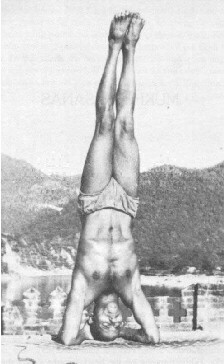
SIRSHASANA
BENEFITS
This is very useful in keeping up Brahmacharya. It makes you Oordhvaretas. The seminal energy is transmuted into spiritual energy, Ojas-Shakti. This is also called sex-sublimation. You will not have wet-dreams, Spermatorrhea. In an Oordhvareto-Yogi the seminal energy flows upwards into the brain for being stored up as spiritual force which is used for contemplative purposes (Dhyana). When you do this Asana, imagine that the seminal energy is being converted into Ojas and is passing along the spinal column into the brain for storage.
Sirshasana is really a blessing and a nectar. Words will fail to adequately describe its beneficial results and effects. In this Asana alone, the brain can draw plenty of Prana and blood. Memory increases admirably. Lawyers, occultists and thinkers will highly appreciate this Asana. This leads to natural Pranayama and Samadhi by itself. No other effort is necessary. If you watch the breath, you will notice it becoming finer and finer. In the beginning of practice there will be a slight difficulty in breathing. As you advance in practice, this vanishes entirely. You will find real pleasure and exhilaration of spirit in this Asana.
Great benefit is derived by sitting for meditation after Sirshasana. You can hear Anahata sound quite distinctly. Young, robust persons should perform this Asana. Householders who practise this should not have frequent sexual intercourse.
6. Sarvangasana (All-Members Pose)
This is a mysterious Asana which gives wonderful benefits. Spread a thick blanket on the floor and practise this Asana on the blanket. Lie on the back quite flat. Slowly raise the legs. Lift the trunk, hips, and legs quite vertically. Support the back with the two hands, one on either side. Rest the elbows on the ground. Press the chin against the chest (Jalandhara Bandha). Allow the back-shoulder portion and neck to touch the ground closely. Do not allow the body to shake or move to and fro. Keep the legs straight. When the Asana is over, bring the legs down very, very slowly with elegance and not with any jerks. In this Asana the whole weight of the body is thrown on the shoulders. You really stand on the shoulders with the help and support of the elbows. Concentrate on the Thyroid gland which lies on the front lower part of the neck. Retain the breath as long as you can do with comfort, and slowly exhale through the nose. You can do this Asana twice daily, morning and evening. This should immediately be followed by Matsyasana (fish-posture). This will relieve pains in the back part of the neck and intensify the usefulness of Sarvangasana. Stand on the Asana for two minutes and gradually increase the period to half an hour.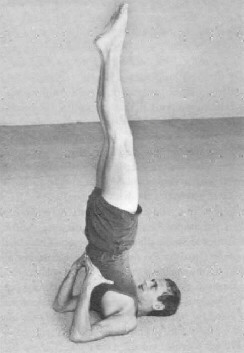
SARVANGASANA
BENEFITS
This is a panacea, a cure-all, a sovereign specific for all diseases. It brightens the psychic faculties and awakens Kundalini Sakti, removes all sorts of diseases of intestine and stomach, and augments the mental power.
It supplies a large quantity of blood to the roots of spinal nerves. It is this Asana which centralises the blood in the spinal column and nourishes it beautifully. But for this Asana there is no scope for these nerve-roots to draw sufficient blood-supply. It keeps the spine quite elastic. Elasticity of the spine means everlasting youth. It stimulates you in your work. It prevents the spine from early ossification (hardening). So you will preserve and retain your youth for a long time. It helps a lot in maintaining Brahmacharya. Like Sirshasana, it makes you an Oordhvaretas. It checks wet-dreams effectively. It rejuvenates those who have lost their potency. It acts as a powerful blood-tonic and purifier. It tones the nerves and awakens Kundalini. Spinal column is rendered very soft and elastic. This Asana prevents the early ossification of the vertebral bones. Ossification is quick degeneration of bones. Old age manifests quickly on account of early ossification. The bones become hard and brittle in the degenerative process. He who practises Sarvangasana is very nimble, agile, full of energy. The muscles of the back are alternately contracted, relaxed and then pulled and stretched. Hence they draw a good supply of blood by these various movements and are well nourished. Various sorts of myalgia (muscular rheumatism), lumbago, sprain, neuralgia, etc., are cured by this Asana.
The vertebral column becomes as soft and elastic as rubber. It is twisted and rolled as it were like a piece of canvas sheet. A man who practises this Asana can never become lazy even a bit. He is a two-legged talking squirrel. The vertebral column is a very important structure. It supports the whole body. It contains the spinal cord, spinal nerve and sympathetic system. In Hatha Yoga the spine is termed as Meru Danda. Therefore you must keep it healthy, strong and elastic. The muscles of the abdomen, the rectic muscles and the muscles of the thigh are also toned and nourished well. Obesity or corpulence and habitual chronic constipation, Gulma, congestion and enlargement of the liver and spleen are cured by this Asana.
7. Matsyasana (Fish Posture)
This Asana will help one to float on water easily with Plavini Pranayama. Therefore it is called fish-pose, Matsyasana. Spread a blanket and sit on Padmasana by keeping the right foot over the left thigh and the left over right thigh. Then lie flat on the back. Hold the head by the two elbows. This is one variety. Stretch the head back, so that the top of your head rests on the ground firmly on one side and the buttocks only on the other, thus making a bridge or an arch of the trunk. Place the hands on the thighs or catch the toes with the hands. You will have to give a good twisting to the back. This variety is more efficacious than the former one. The benefits that you derive from this variety are a hundred times more than what you get in the previous variety. Those fatty persons with thick calves, who find it difficult to have Padmasana (foot-lock), may simply sit in the ordinary way and then practise this Asana. Practise the Padmasana first. Make it firm, easy and steady. Then take Matsyasana. Do this Asana for 10 seconds in the beginning and increase it to 10 minutes. When you have finished the Asana, slowly release the head with the help of hands and get up. Then unlock the Padmasana. You must practise this Asana soon after Sarvangasana. It will relieve stiffness of the neck and all crampy conditions of the cervical region caused by long practice of Sarvangasana. This gives natural massage or shampooing to the congested parts of the neck and shoulders. Further it affords the maximum benefits of Sarvangasana. It is a complimentary Asana of Sarvangasana. Rather it supplements Sarvangasana. As the larynx or wind-box and trachea (wind-pipe) are thrown open widely, this Asana helps deep breathing. Matsyasana is the destroyer of many diseases. It removes constipation. It brings down the accumulated faecal matter to the rectum. It is useful in asthma, consumption, chronic bronchitis, etc., on account of the deep breathing.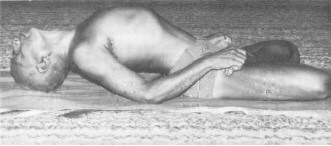
MATSYASANA
8. Paschimottanasana
Sit on the ground and stretch the legs stiff like a stick. Catch the toes with the thumb and index and middle fingers. While catching, you have to bend the trunk forwards. Fatty persons will find it rather difficult to bend. Exhale. Slowly bend without jerks till your forehead touches your knees. You can keep the face even between the knees. When you bend down, draw the belly back. This facilitates the bending forward. Bend slowly by gradual degrees. Take your own time. There is no hurry. When you bend down, bend the head between the hands. Retain it on a level with them. Young persons with elastic spine can touch the knees with the forehead even in their very first attempt. In the case of grown-up persons with rigid spinal column, it will take a fortnight or a month for complete success in the posture. Retain the breath till you take the forehead back, to its original position, till you sit straight again. Then breathe. Retain the pose for 5 seconds. Then gradually increase the period to 10 minutes. Those who find it difficult to do the full Paschimottanasana, can do half pose with one leg and one hand and then with the other leg and hand. They will find this more easy. After some days when the spine has become more elastic, they can have recourse to the full pose. You will have to use common-sense while practising Yogasanas.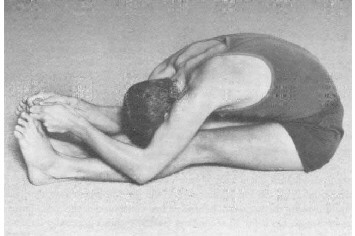
PASCHIMOTTANASANA
BENEFITS
This is an excellent Asana. It makes the breath flow through the Brahma Nadi and Sushumna, and rouses the gastric fire. It reduces fat in the abdomen and makes the loins lean. This Asana is a specific for corpulence or obesity. It brings about reduction of spleen and liver in cases of enlargement of spleen. What Sarvangasana is for the stimulation of endocrine glands, so is Paschimottanasana for the stimulation of abdominal viscera, such as kidneys, liver, pancreas, etc. This Asana relieves constipation, removes sluggishness of liver, dyspepsia, belching and gastritis. Lumbago and all sorts of myalgia of the back muscles are cured. This Asana cures piles and diabetes also. The muscles of the abdomen, the solar plexus, the epigastric plexus, bladder prostate, lumbar nerves, sympathetic cord are all toned up and kept in a healthy, sound condition.
9. Mayurasana (Peacock Pose)
This is more difficult than Sarvangasana. This demands good physical strength. Kneel on the ground. Sit on the toes. Raise the heels up. Join the two forearms together. Place the palms of the two hands on the ground. The two little fingers must be in close touch. They project towards the feet. Now you have got steady and firm forearms for supporting the whole body in the ensuing elevation of the trunk and legs. Now bring down the abdomen slowly against the conjoined elbows. Support your body upon your elbows that are pressed now against the navel or umbilicus. This is the first stage. Stretch your legs and raise the feet stiff and straight on a level with the head. This is second stage. Neophytes (beginners) find it difficult to keep up the balance as soon as they raise the feet from the ground. Place a cushion in front. Sometimes you will have a fall forwards and you may hurt your nose slightly. Try to slip on the sides when you cannot keep up the balance. If you find it difficult to stretch the two legs backwards at one stroke, slowly stretch one leg first and then the other. If you adopt the device of leaning the body forwards and head downwards the feet will by themselves leave the ground and you can stretch them quite easily. When the Asana is in full manifestation the head, trunk, buttocks, thighs, legs and feet will be in one straight line and parallel to the ground. This posture is very beautiful to look at. Beginners can practise this Asana by holding on to a table. They will find it easy to practise this. If you understand the technique of this Asana and if you use your common-sense you can do it easily and can keep up the balance without much difficulty. Fatty people have frequent nasty falls, slips and doublings and they excite much laughter amongst the onlookers. Do not bend the legs when you stretch them. Practise this Asana from 5 to 20 seconds. Those who have good physical strength can do it for 2 or 3 minutes. Retain the breath when you raise the body. It will give you immense strength. When you finish the Asana, exhale slowly.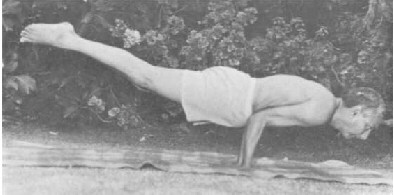
MAYURASANA
BENEFITS
This is a wonderful Asana for improving digestion. It destroys the effects of unwholesome food, and increases the digestive power. It cures dyspepsia and diseases of the stomach like Gulma (chronic gastritis), and reduces spleenic and liver enlargements by increasing the intra-abdominal pressure. The whole abdominal organs are properly toned and stimulated well by the increase of intra-abdominal pressure. Sluggishness of liver or hepatic torpidity disappears. It tones the bowels and removes constipation (ordinary, chronic and habitual). It awakens Kundalini.
10. Ardha Matsyendrasana
Paschimottanasana and Halasana bend the spine forwards. Dhanur, Bhujanga and Salabha Asanas are counter-poses to bend the spine backwards. This is not sufficient. It must be twisted and bent from side to side also (lateral movements). Then only perfect elasticity of the spinal column can be ensured. The Matsyendrasana serves this purpose well in giving a lateral twist to the spinal column. Place the left heel near the anus and below the scrotum. It can touch the perennial space. Do not allow the heel to move from this space. Bend the knee and place the right ankle at the root of the left thigh and rest the right foot well on the ground close to the left hip-joint. Place the left axilla or arm-pit over the top of the vertically bent right knee. Push the knee now a little to the back so that it touches the back part of the axilla. Catch hold of the left foot with left palm. Then applying pressure at the left shoulder-joint slowly twist the spine and turn to the extreme right. Turn the face also to the right as much as you can do. Bring it in a line with the right shoulder. Swing round the right arm towards the back. Catch hold of the left thigh with the right hand. Retain the pose from 5 to 15 seconds. Keep the vertebral column erect. Do not bend. Similarly you can twist the spine to the left side.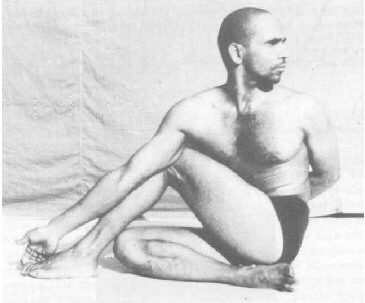
ARDHA MATSYENDRASANA
BENEFITS
This Asana increases appetite by increasing the digestive fire. It destroys terrible diseases. It rouses Kundalini and makes the moon-flow, Chandranadi, steady. Above the root of the palate the moon is said to be located. It drops the cool ambrosial nectar, which is wasted by mixing with gastric fire. But this Asana prevents it.
It keeps the spine elastic and gives a good massage to the abdominal organs. Lumbago and all sorts of muscular rheumatism of the back-muscles are cured. The spinal nerve-roots and sympathetic system are toned. They draw a good supply of blood. This Asana is an adjunct to Paschimottanasana.
11. Vajrasana (The Adamantine Pose)
Those who sit in this Asana have a quite steady and firm pose. They cannot be easily shaken. The knees are rendered very hard. Merudanda becomes firm and strong. This Asana resembles more or less the Namaz pose in which the Muslims sit for prayer. Keep the soles of the feet on both sides of the anus, i.e., place the thighs on the legs one over the other and the soles on the buttocks. The calves must touch the thighs. The part from the toe to the knee should touch the ground. The whole burden of the body is put on the knees and ankles. In the beginning of practice you may feel a slight pain in the knee and ankle-joints but it passes off very quickly. Massage the painful parts and two joints with the hands. You can use a little Iodex or Amrutanjan for rubbing. After fixing the feet and the knees, put both the hands straight on the knees. Keep the knees quite close. Sit like this keeping the trunk, neck and head in one straight line. This is the most common Asana. You can sit in this Asana for a very long time comfortably. Yogins generally sit in this Asana.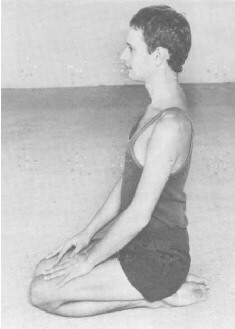
VAJRASANA
BENEFITS
If you sit in this Asana for fifteen minutes immediately after food, the food will be digested well. Dyspeptics will derive much benefit. The Nadis, nerves and muscles of the legs and thighs are strengthened. Myalgia in the knees, legs, toes and thighs disappears. Sciatica vanishes. Flatulence is removed. Stomach exercises a stimulating, beneficial influence on Kanda, the most vital part from which all the Nadis spring.
12. Urdhva Padmasana (Above Lotus Pose)
Perform Sirshasana. Slowly bend the right leg and keep it on the left thigh and keep the left leg on the right thigh. You must do this very carefully and slowly. If you can stand in Sirshasana for more than 10 or 15 minutes, then you can attempt this. Otherwise you will have a fall and injure your legs. A gymnast, who can balance on the parallel bars on the ground, can do this. The benefits of Sirshasana can be realised from this Asana.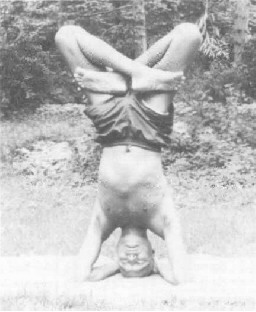
URDHVA PADMASANA
No comments:
Post a Comment